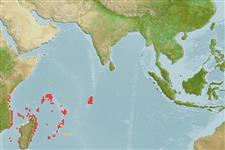>
Eupercaria/misc (Various families in series Eupercaria) >
Nemipteridae (Threadfin breams, Whiptail breams)
Etymology: Scolopsis: Greek, skolex = worm + Greek, opsis = appearance (Ref. 45335).
More on author: Cuvier.
Environment: milieu / climate zone / depth range / distribution range
Ecologia
marinhas associadas(os) a recifes; intervalo de profundidade 5 - 20 m (Ref. 9710). Tropical; 1°S - 23°S, 39°E - 75°E (Ref. 3810)
Western Indian Ocean: including the Seychelles, Chagos Archipelago, Mauritius, Réunion and Madagascar.
Tamanho / Peso / Idade
Maturity: Lm ? range ? - ? cm
Max length : 26.0 cm TL macho/indeterminado; (Ref. 9710); common length : 17.0 cm SL macho/indeterminado; (Ref. 3810)
Espinhos dorsais (total): 10; Raios dorsais moles (total): 9; Espinhos anais 3; Raios anais moles: 7. Head scales reaching to between anterior margin of eyes and posterior nostrils. Lower limb of preopercle naked. Antrorse (forward-directed) suborbital spine absent. Pelvic fins long, reaching to or just beyond level of anus. Upper lobe of caudal fin slightly longer than lower lobe in larger specimens. Axillary scale present. Color: Upper body blue or olive green, white below. A yellow stripe from top of snout, through upper part of eye and arching on back to upper part of caudal peduncle. A narrow yellow stripe from top of head running along base of dorsal fin, this stripe disappearing with age. Juveniles blue on upper half of body, white below.
Inhabits sandy bottoms close to coral reefs. Occurs in small groups. Juveniles are solitary (Ref. 9710).
Life cycle and mating behavior
Maturidade | Reprodução | Desova | Ovos | Fecundidade | Larvas
Russell, B.C., 1990. FAO Species Catalogue. Vol. 12. Nemipterid fishes of the world. (Threadfin breams, whiptail breams, monocle breams, dwarf monocle breams, and coral breams). Family Nemipteridae. An annotated and illustrated catalogue of nemipterid species known to date. FAO Fish. Synop. 125(12):149p. Rome: FAO. (Ref. 3810)
Categoria na Lista Vermelha da IUCN (Ref. 130435)
Ameaça para o homem
Harmless
Utilização humana
Pescarias: pescarias de subsistência
Mais informação
Nomes comunsSinónimosMetabolismoPredadoresEcotoxicologiaReproduçãoMaturidadeDesovaAgregação para desovaFecundidadeOvosDesenvolvimento dos ovos
ReferênciasAquaculturaPerfil para aquaculturaEstirpesGenéticaElectrophoresesHereditariedadeDoençasProcessamentoNutrientsMass conversion
Ferramentas
Relatórios especiais
Descarregue XML
Fontes da internet
Estimates based on models
Preferred temperature (Ref.
123201): 25.7 - 28.2, mean 27.5 °C (based on 219 cells).
Phylogenetic diversity index (Ref.
82804): PD
50 = 0.5000 [Uniqueness, from 0.5 = low to 2.0 = high].
Bayesian length-weight: a=0.01622 (0.00730 - 0.03605), b=2.98 (2.80 - 3.16), in cm total length, based on LWR estimates for this Genus-body shape (Ref.
93245).
Nível Trófico (Ref.
69278): 3.3 ±0.39 se; based on food items.
Resiliência (Ref.
120179): Elevada, tempo mínimo de duplicação da população menor que 15 meses (Preliminary K or Fecundity.).
Fishing Vulnerability (Ref.
59153): Low vulnerability (16 of 100).
Nutrients (Ref.
124155): Calcium = 64.5 [40.9, 132.2] mg/100g; Iron = 0.692 [0.339, 1.632] mg/100g; Protein = 19 [17, 21] %; Omega3 = 0.137 [0.082, 0.228] g/100g; Selenium = 25.4 [15.0, 46.2] μg/100g; VitaminA = 75 [20, 222] μg/100g; Zinc = 1.39 [0.97, 2.05] mg/100g (wet weight);
